Buy
at AllPosters.com



MADRID
- Old Quarter - Historic Centre FEATURED HOTELS
|
|
 Search
for more Madrid Hotels
Search
for more Madrid Hotels
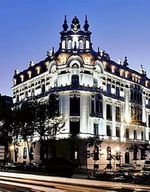 |
Hotel
AC Palacio del Retiro, Madrid
Built as a palace in 1908
and converted into a hotel in 2004, the AC Palacio del Retiro is a national
heritage site, which features original sweeping marble staircases and stained
glass windows. The hotel is situated in the city centre, 300 metres from
the Prado Museum. The Reina Sofia Art Centre is 500 metres away, and the
Running of the Bulls takes place at Plaza de Toros, five kilometres away.
Guests can work out in the fitness centre and then unwind in the sauna.
Those seeking total relaxation can indulge in a variety of spa and massage
treatments, including in-room massages. Diners can enjoy modern Mediterranean
cuisine in a relaxed setting at the restaurant Indice. Before dinner, guests
can enjoy cocktails in the bar, or relax and take advantage of 24-hour
room service. Parents will appreciate the babysitting service. |
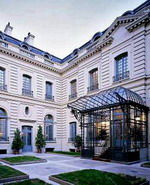 |
AC
Santo Mauro Hotel, Madrid
This palace with its end
of nineteenth century style was built on the orders of the Duke of Santo
Mauro by the French architect Louis Legrand. It was finished in the year
1894. The building, with its notable French influence, was the residence
of the Duke of Santo Mauro and later became the embassy of the Philippines.
The hotel is located in the heart of the Chamberí neighbourhood
of Madrid, very near to the Paseo de la Castellana, the place favoured
by the nobility to construct their little palaces at the end of the nineteenth
century, a symbol of their economic power. The restaurant is in the
old library of the palace. It is under the orders of prestigious chef Carlos
Posadas who offers a menu which changes every three to four months and
which perfectly combines varied international cuisine with the most traditional
and straightforward dishes. The bedrooms are equipped with
everything necessary: complete bathroom, hair-dryer, music equipment, TV,
safe deposit box, individual air-conditioning and heating, and free mini-bar. |
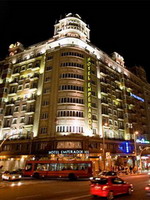 |
Hotel
Emperador, Madrid
The Hotel Emperador in Madrid
Spain is located on Madrid's Gran Via. The theater and cinema district
is 950 meters from the hotel. Prado Museum is less than two kilometers
away and contemporary and modern art at the Reina Sofia Museum is four
kilometers from the hotel. The lobby features marble floors and floor-to-ceiling
pillars and an atrium. The 24-hour front desk offers amenities that include
complimentary newspapers in the lobby. A bar on the roof serves light food.
The seasonal pool on the roof of the Hotel Emperador offers spectacular
views of Madrid's landmarks. The hotel's piano bar features a pool table.
The hotel also offers a spa sauna and gymnasium. Famous Spanish painters,
such as Pablo Picasso and Francisco Goya, are commemorated in the hotel's
10 meeting rooms. High-speed Internet access is available, for a fee. |
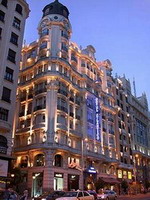 |
Hotel
Atlantico Madrid
The Atlantico Hotel in Madrid
is a stately building, topped by a French-style dome from which a great
part of the city can be seen. Situated in the heart of Madrid, it makes
the ideal lodging choice. This first class property is strategically located
only 18 kilometers northwest of the Barajas Airport. This hotel does its
very best to offer guests the best service possible so that they will feel
as if they are at home. Guests will be able to enjoy a cafeteria and lounge
with a panoramic view of Madrid and then retire to a comfortable room.
Approximately 1000 meters separates the hotel from the cultural triangle
composed of the three major museums: the Prado Museum, the Reina Sofia
Museum and the Thyssan Bornemisza Museum. A cordial and attentive
staff is on-site to assist you with any needs that you might have. This
property is moments away from fine dining, shopping and entertainment venues. |
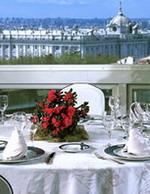 |
Hotel
Santo Domingo, Madrid
Housed in an historic sixteenth
century building, the Santo Domingo is decorated with a style in keeping
with its rich history and tradition, filled with original artwork and antique
furniture throughout. Situated in a quiet Plaza in the heart of Madrid,
it is just 200 meters from the Royal Palace. Spanish and international
cuisine is served in the relaxed ambience of the Best Western Premier Santo
Domingo restaurant, decorated with warm colors and 17th century paintings.
Guests can relax in the lobby with a complimentary newspaper, and plan
excursions in the Internet corner or with the help of the multilingual
staff at the front desk. For business guests there are conference
rooms, as well as banquet facilities. For fitness enthusiasts the hotel
provides access to a nearby gymnasium. Visitors to Madrid are surrounded
by attractions and art lovers are one kilometer from the major museums
including the Prado, home to one of Europe's most renowned art collections. |
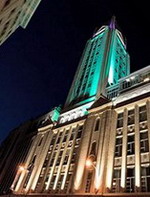 |
Petit
Palace Alcala, Madrid
Occupying an opulent early
1900s building in Madrid's historical centre, the contemporary, high-tech
Petit Palace Alcala lies 100 metres from the bustling Gran Via. Madrid
Barajas Airport is 15 kilometres from the hotel, a 25-minute drive away.
This modern hotel offers complimentary wireless Internet access throughout
and offers personal computers. Parking is available nearby for those arriving
by car, while other practical amenities include a business centre, a 24-hour
front desk, laundry facilities, safe-deposit boxes, and meeting rooms.
Bicycles are available. Coffee, teas, and juices are available in the lobby
bar from 12 p.m. to 10 p.m. Buffet breakfasts are offered on the 5th floor,
with views of Madrid. Pets weighing up to 15 kg are permitted. Dog beds
and feeding dishes are provided. Guests with pets should contact the hotel
prior to arrival. |
Search
for more Madrid Hotels


Plaza
Mayor - Madrid Travel Information
| The
Plaza Mayor built
during the Habsburg period is a central plaza in the city of Madrid, Spain.
It is located only a few blocks away from another famous plaza, the Puerta
del Sol. The Plaza Mayor is rectangular in shape, measuring 129 by 94 meters,
and is surrounded by three-story residential buildings having 237 balconies
facing the Plaza. It has a total of nine entranceways. The Casa de la Panadería,
serving municipal and cultural functions, dominates the Plaza Mayor.
The origins of the Plaza
go back to 1581 when Philip II of Spain asked Juan de Herrera, a renowned
Renaissance architect, to discuss a plan to remodel the busy and chaotic
area of the old Plaza del Arrabal. Juan de Herrera was the architect who
designed the first project in 1581 to remodel the old Plaza del Arrabal
but construction didn't start until 1617, during Philip III's reign. The
king asked Juan Gomez de Mora to continue with the project, and he finished
the porticoes in 1619. |

Plaza
Mayor from the East, Madrid, Spain
Buy
at AllPosters.com
|


Building
Facades in Plaza Mayor, Madrid
Buy
at AllPosters.com
|
Nevertheless, the Plaza
Mayor as we know it today is the work of the architect Juan de Villanueva
who was entrusted with its reconstruction in 1790 after a spate of big
fires. Giambologna's equestrian statue of Philip III dates to 1616, but
it was not placed in the center of the square until 1848. Amazingly enough
if you go in there today you can still see the blood on the walls from
some of the bull fights held there in earlier years.
The name of the plaza has
changed over time. Originally it was called the "Plaza del Arrabal" but
became known as the "Plaza Mayor".
In 1812, following a decree
all the major plazas of Spain were renamed "Plaza de la Constitución",
in honour of the Constitution of 1812. |

The plaza had this name
until the restoration of the Borbón king in 1814 when it became
known as the "Plaza Real". The plaza once again held the name "Plaza de
la Constitución" in the periods from 1820 to 1823, 1833 to 1835,
and 1840 to 1843.

| In 1873, the name changed
to "Plaza de la República", and then back to "Plaza de la Constitución"
from the restoration of Alfonso XII in 1876 to the dictatorship of Primo
de Rivera in 1922. A proclamation of the Second Spanish Republic gave the
plaza the name of "Plaza de la Constitución" until the end of the
Spanish Civil War when the plaza was renamed the "Plaza Mayor," the name
it bears to date.
Uses:
The Plaza Mayor has been
the scene of multitudinous events: markets, bullfights, soccer games, public
executions, and, during the Spanish Inquistion, "autos de fe" against supposed
heretics and the executions of those condemned to death. The Plaza Mayor
also has a ring of old and traditional shops and cafes under its porticoes.
Celebrations for San Isidro, patron saint of Madrid, are also held here.
The Plaza Mayor is now a major tourist attraction, visited by thousands
of tourists a year. |

Relaxing
on Plaza Mayor, Madrid, Spain
Buy
at AllPosters.com
|
 |
|
Top
|
Plaza
de Cibeles Madrid Travel Information

18th
Century Cibeles Fountain at Night, Madrid, Spain
Buy
at AllPosters.com
|
The
Plaza de Cibeles
is an attractive square featuring a famous sculpture with fountains that
have been adopted as one of the prominent symbols for the city of Madrid.
The fountain of Cibeles is
found in the part of Madrid commonly called the Paseo de Recoletos. It
depicts the goddess Cibeles (Cybele), the Phrygian goddess of fertility,
who is seen sitting on a chariot and being pulled by two lions. On one
side of the fountain of Cibeles, the Paseo de Recoletos starts, heading
north to join up with the Paseo de la Castellana. On the other side, the
Paseo del Prado begins and heads off south, towards the fountain of Neptune,
in the Plaza de Cánovas del Castillo, and on until Atocha. Up until
the 19th century both the fountain of Neptune and Cibeles looked directly
at each other, until the city council decided to turn them round to face
towards the centre of the city. |

| Calle Alcalá is the
street which intersects the fountain from east to west. Calle Alcalá
starts in the Puerta del Sol and continues on to the outskirs of Madrid.
On the corners of Cibeles ‘square’ the old headquarters of the Spanish
Postal Service (Correos y Telégrafos) and nowadays the Mayor's Office
is found. On another corner the Bank of Spain is found and opposite to
the General Staff Headquarters of the Spanish Army. The East side of the
square is occupied by the Palace of Linares, that currently hosts the Casa
de América.
The Cibeles fountain was
built in the reign of Charles (Carlos) III and designed by Ventura Rodríguez
between 1777 and 1782. The goddess and chariot are the work of Francisco
Gutiérrez and the lions by Roberto Michel.
The fountain of Cibeles has
been adopted by the football team Real Madrid as the place to celebrate
it triumphs in major competitions such as the Champions League, La Liga
or Spanish Copa del Rey. |

Plaza
de Cibeles, Cibeles Fountain, Madrid, Madrid, Spain
Buy
at AllPosters.com
|

Subway station (Metro de
Madrid): Banco de España (line 2). |
|
Top
|
Puerta
del Sol Madrid Travel Information
| The
Puerta del Sol
(Spanish for "Gate of the Sun") is one of the most well known and busiest
places in Madrid. This is the centre (Km 0) of the radial network of Spanish
roads. The square also contains the famous clock whose bells mark the traditional
eating of the Twelve Grapes and the beginning of a new year. The New Year's
celebration has been broadcast live on TV since 31 December 1962.
The Puerta del Sol originated
as one of the gates in the city wall that surrounded Madrid in the 15th
century. Outside the wall, medieval suburbs began to grow around the Christian
Wall of the 12th century. The name of the gate came from the rising sun
which decorated the entry, since the gate was oriented to the east.
Between the 17th and 19th
centuries, the area was an important meeting place: as the goal for the
couriers coming from abroad and other parts of Spain to the Post Office,
it was visited by those eager for the latest news. |

Puerta
Del Sol, Madrid, Spain
Buy
at AllPosters.com
|

The stairs to the Saint
Philip church at the square were known as the Gradas de San Felipe, and
were among the most prolific mentideros de la Corte (approx. trans. would
be "lie-spreaders of the Court").


Puerta
Del Sol, Madrid, Spain
Buy
at AllPosters.com
|
The House of the Post Office
was built by French Architect Jacques Marquet between 1766 and 1768. The
building was the headquarters of the Ministry of Interior and State Security
during the Francisco Franco dictatorship. It is currently the seat of the
Presidency of the Madrid Community.
Famous buildings and landmarks
-
Bear and the Madroño
Tree, heraldic symbol of Madrid
-
Monument to King Charles III
-
The kilómetro cero (kilometer
zero) on the pavement in front of the House of the Post Office.
-
The Tío Pepe advertisement
is a landmark
|

The Puerta del Sol contains
a number of well known sights associated both domestically and internationally
with Spain. On the south side, the old Post Office serves as the office
of the President of Madrid, the head of the regional government of the
Autonomous Community of Madrid (not to be confused with the Madrid City
Council, which is housed elsewhere). Also on its south side, the square
holds a mounted statue of Charles III of Spain, nicknamed "el rey alcalde"
("the king mayor") due to the extensive public works programme he set in
motion. The famous Tio Pepe lighted sign is above the square's eastern
building between the Calle de Alcalá and the Carrera de San Jerónimo.
On the north side lies a statue of a bear and a madrone tree (madroño),
the heraldic symbol of Madrid. The Mariblanca (actually Venus) marks the
place of a former fountain.
The kilómetro cero
is a plaque on the ground directly north of the Post Office serving as
the symbolic center of Spain. In addition to signaling the basis of numbering
in the Spanish road system, the symbolic nature of the plaza ensures that
it is the site of many rallies and protests, particularly against violence
and war. Sol has seen protests against the terrorism perpetrated by ETA,
the March 11th attacks on commuter trains, and Spain's involvement in the
Iraq War.
Location in Madrid
The Puerta is located in
the very heart of Madrid. Immediately to the southwest lies the Plaza Mayor;
the Palacio Real, the official home of the Royal Family, is further west.
Parliament and the museum district are to the east and the train station
Atocha is to the southeast. |
|
Top
|
|

